|
⇐ Previous Article — Table of Contents — Next Article ⇒
New Energy Times home page
17. The Cold Fusion Belief System
By Steven B. Krivit
For two decades, "cold fusion" researchers have at times been accused of being "true believers." Has this been a fair critique?
The first step in the scientific process begins with "observation," which leads to "hypothesis.” It does not begin with "belief"; nor is "belief" part of the process.
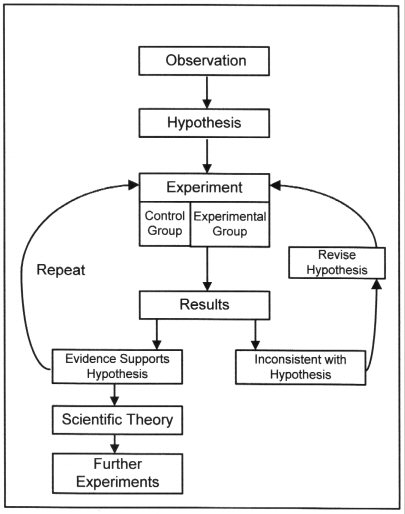
Scientific Process (Method.) Diagram provided courtesy of William S. Gaud, Professor Emeritus, Department of Biological Sciences, Ph.D. University of North Carolina, based on an original diagram by Wendy Gorman.
The D+D "cold fusion" belief system can best be understood by a quote from LENR-CANR.org librarian and former computer programmer Jed Rothwell to New Energy Times on Dec. 29, 2009.
"In the case of cold fusion," Rothwell wrote, "we know the reaction does not happen without deuterium and a lattice, and we know it produces helium. The only thing in the system that can convert to helium is deuterium, and the ratio of heat to helium is close to that of plasma fusion, so that has to be it."
To be fair, "cold fusion" discoverer Stanley Pons, as early as April 1989, suggested that the amount of helium-4 produced in his and his colleague Martin Fleischmann's fusion experiment agreed roughly with the thermonuclear fusion branch which releases 24 MeV of energy through gamma radiation.
But that was 21 years ago: long before the many experiments attempting to confirm the possible relationship between heat and helium-4; long before the experiments revealed a very broad energy range (12-89 MeV); long before New Energy Times exposed the problems with SRI electrochemist Michael McKubre's "M4" experiment.
Still, Rothwell can be faulted only for unquestionably repeating the D+D "cold fusion" mantra from MIT electrical engineering professor Peter Hagelstein, who repeated the assertion of 24 MeV as recently as March 21, 2010.
In the text he provided for the American Chemical Society's "cold fusion" press release, Hagelstein stated that, "in the experiments, a large amount of energy is produced and He-4 is observed, with about 24 MeV of energy measured per helium atom detected."
Melvin Miles, a meticulous electrochemist and as straight a shooter as scientists come, told me that "helium-4 was the only product that [he] found that could explain the [amount of] excess heat."
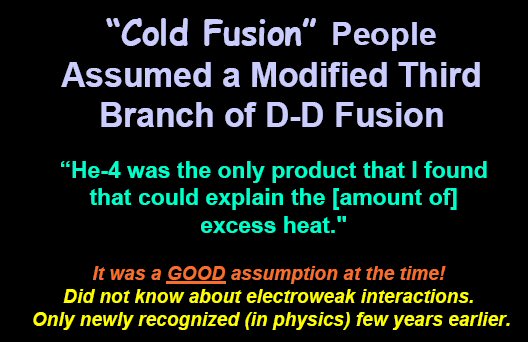
Slide #3 from Krivit presentation prepared for but not presented at American Chemical Society meeting
in San Francisco, Calif.
And it was indeed a good assumption at the time, because few people, particularly electrochemists, had any idea about electroweak interactions.
The 24 MeV Myth
For a while, for some people, D+D "cold fusion" seemed to be real, based on the so-called correlation of 24 MeV of heat to helium-4 and the neglect of all other nuclear products in the LENR cell.

Scott Chubb told New Energy Times that McKubre proved "cold fusion."
On Jan. 29, I published New Energy Times #34 and exposed the flaws in McKubre's 24 MeV claim. McKubre's only response was to inform my board of directors that I had made serious errors, misrepresentations and omissions although he failed to identify a single example.
Two months later, on March 21, despite the exposure of the flaws with the 24 MeV claim, Hagelstein spoke at the American Chemical Society "cold fusion" press conference about 24 MeV as if nothing had changed.
"[There are] a number of experiments – more than 10 experiments where people have seen that kind of thing – and there's two measurements where the correlation shows a Q-value or an energy per helium-4 of about 24 MeV," Hagelstein said.
Two years earlier, in August 2008, he told the ICCF-14 audience that he would "like to believe" that the energy release was 24 MeV.
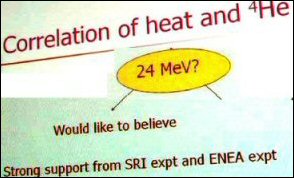
Slide from Hagelstein presentation at ICCF-14 in Washington, D.C.
In October 2008, New Energy Times published an extensive review of the 24 MeV belief, held by Hagelstein and several other LENR researchers. Hagelstein did not admit his belief in 24 MeV publicly after that.
On March 21, I had the opportunity to ask McKubre face to face for an explanation of his claims of 24 MeV. He gave his response in a live Webcasted press conference hosted by the American Chemical Society. The details of this matter are covered in depth in "When Nuclear Is Not Enough: A Tangled Tale of Two Experiments" in this special report.
A day later, on March 22, McKubre's proof disappeared silently at 4:29 p.m. when he concluded his presentation at the American Chemical Society meeting in San Francisco, Calif. For the first time in a decade, McKubre failed to mention his D+D "cold fusion" 24 MeV/4He atom claim, let alone the idea of heat and helium-4 correlation.
McKubre's colleague Vittorio Violante, of ENEA Frascati, also presented at ACS in San Francisco. Violante allegedly had independently replicated and confirmed the 24 MeV claim just two months before the 2004 Department of Energy LENR review organized by McKubre and his "cold fusion" faction colleagues. Violante's ACS presentation also, for the first time in six years, didn’t mention the D+D "cold fusion" 24 MeV.
When McKubre spoke at the June 29 Army Research Laboratory workshop on LENR, the 24 MeV claim was not mentioned, defended or otherwise explained.
When Hagelstein spoke at ARL, he adjusted his representation of the 24 MeV from "about 24 MeV" to "somewhere near 24 MeV." It is still questionable whether the 12-89 MeV reported by New Energy Times is "somewhere near" 24 MeV.
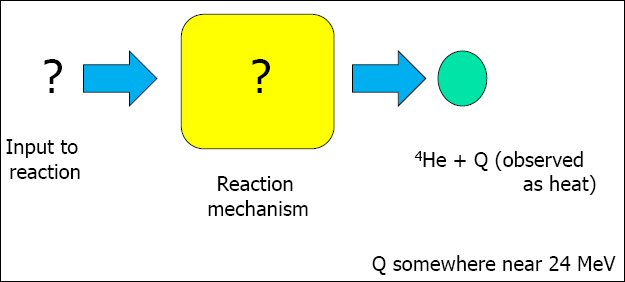
Hagelstein slide #3 from Army Research Labs LENR Workshop, June 29, 2010
Observation or Belief?
We return to the scientific process and use it in an example to distinguish between observation and belief.
Sometime in March 2010, D+D "cold fusion" theorist and technical editor of Infinite Energy magazine Scott Chubb published the following comment, first on the Infinite Energy Web site:
|
A second avenue for future research involves further quantifying a key experimental result: that D+D 4He + 23.8 MeV is the dominant heat-producing reaction. The most precise experiment that documents this finding involved a recycling procedure in which helium-4 that had been trapped inside heat-producing experiments is released into the atmosphere. This experiment, which was named “M4” by the SRI group who conducted it, was performed in 1994. “M4” should either be repeated or more precise measurements should be performed, using other systems potentially involving recycling techniques, to test its conclusions. |
Chubb knew that New Energy Times had exposed the weaknesses in McKubre's "M4" experiment; he knew the other reported 24 MeV claims also had problems. Yet he spoke about 24 MeV as if it were a scientific fact.
I wrote to Chubb and asked him why he perpetuated this myth. He responded with a long list of possible explanations of why McKubre's data failed to show what he and McKubre had initially claimed. I was surprised. Chubb had forgotten the first step in the scientific process: observation. The point was that the 24 MeV had not been observed. I asked him how he accounted for this fact.
"It is not that the helium-4 23.8 MeV reaction must be right all the time," Chubb wrote, "But there is a finite probability that it is, and in quantum mechanics, when a finite probability exists for something, it must take place, at some level."
After 21 years of searching, after the evidence showed that LENR energy release could easily fall between 12 MeV and 89 MeV per helium-4 atom, Chubb was still asserting the hypothesis of 24 MeV. After 21 years of evidence showing a wide variety of other nuclear products with LENR cells, Chubb was still asserting D+D "cold fusion."
I criticized him for failing to distinguish between fact and fantasy.
"The verdict is still out about the 24 MeV reaction," Chubb wrote. "To say otherwise ignores the error bars, the results, etc. ... This is not fantasy.”
The experimental evidence includes rigorously performed and honestly reported data. There is no observation of 24 MeV. This became clear to me. Chubb's continued hypothesis of D+D "cold fusion" in the absence of factual observations was belief.
Chubb is not alone is his failure to distinguish between science and belief. David Nagel, who chaired the ICCF-14 conference in 2008, suggests that "science and religion can be viewed as interrelated."
The Helium-4 Myth
Let us return to part of Rothwell's comment: "The only thing in the system that can convert to helium is deuterium."
On April 3, I had an e-mail exchange with Bob Bass, a mathematician and another D+D "cold fusion" theorist.
Bass was adamant that D+D "cold fusion" was adequately supported by observation and justified by the observations of helium-4, because the third branch of thermonuclear fusion also produced helium-4.
"I have some credibility in hot fusion," Bass wrote, "because my patent-expired Topolotron has been written up in the leading books on the subject (by Tom Dolan and by J. Reece Roth) as a 'promising idea never actually tried.' And enough is known about nuclear physics to assure me that only a finite number of nuclear reactions are even possible in either hot or ‘cold fusion.’ "
I wrote back to Bass and let him know that, according to another theorist, Lewis Larsen, nuclear physics provides innumerable ways to create helium in LENR experiments.
For example, I showed him slide #32 from Larsen's June 25, 2009, slide presentation.
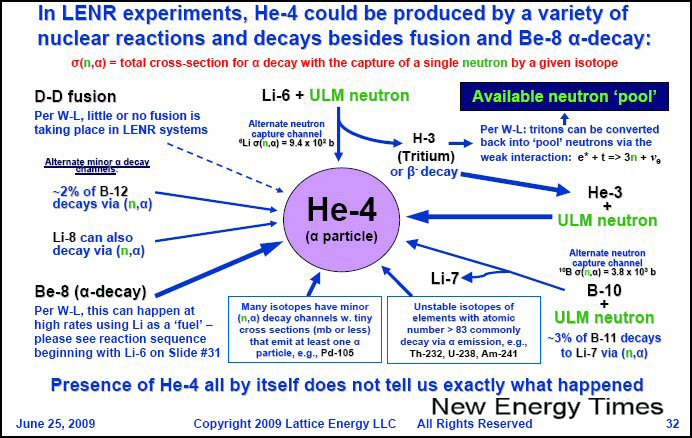
In Larsen's Sept. 3, 2009, presentation slide #5, he goes deeply into nucleosynthesis and introduces a graphical display of a diverse array of some of the possible weak interactions he sees in LENR. The following New Energy Times slide is a simplification that depicts, for example, a beta-delayed alpha decay that can produce helium-4 with a 7.7 MeV release of nuclear binding energy.
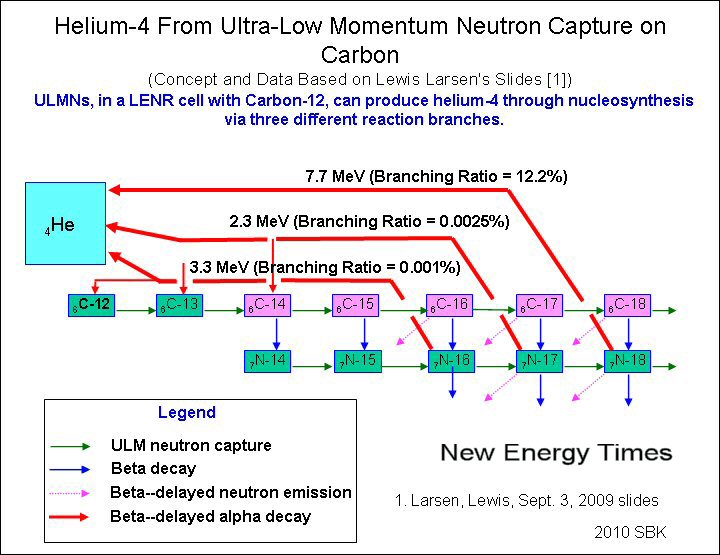
Bass did not respond to my e-mail, and I have not heard from him since.
⇐ Previous Article — Table of Contents — Next Article ⇒ | 
